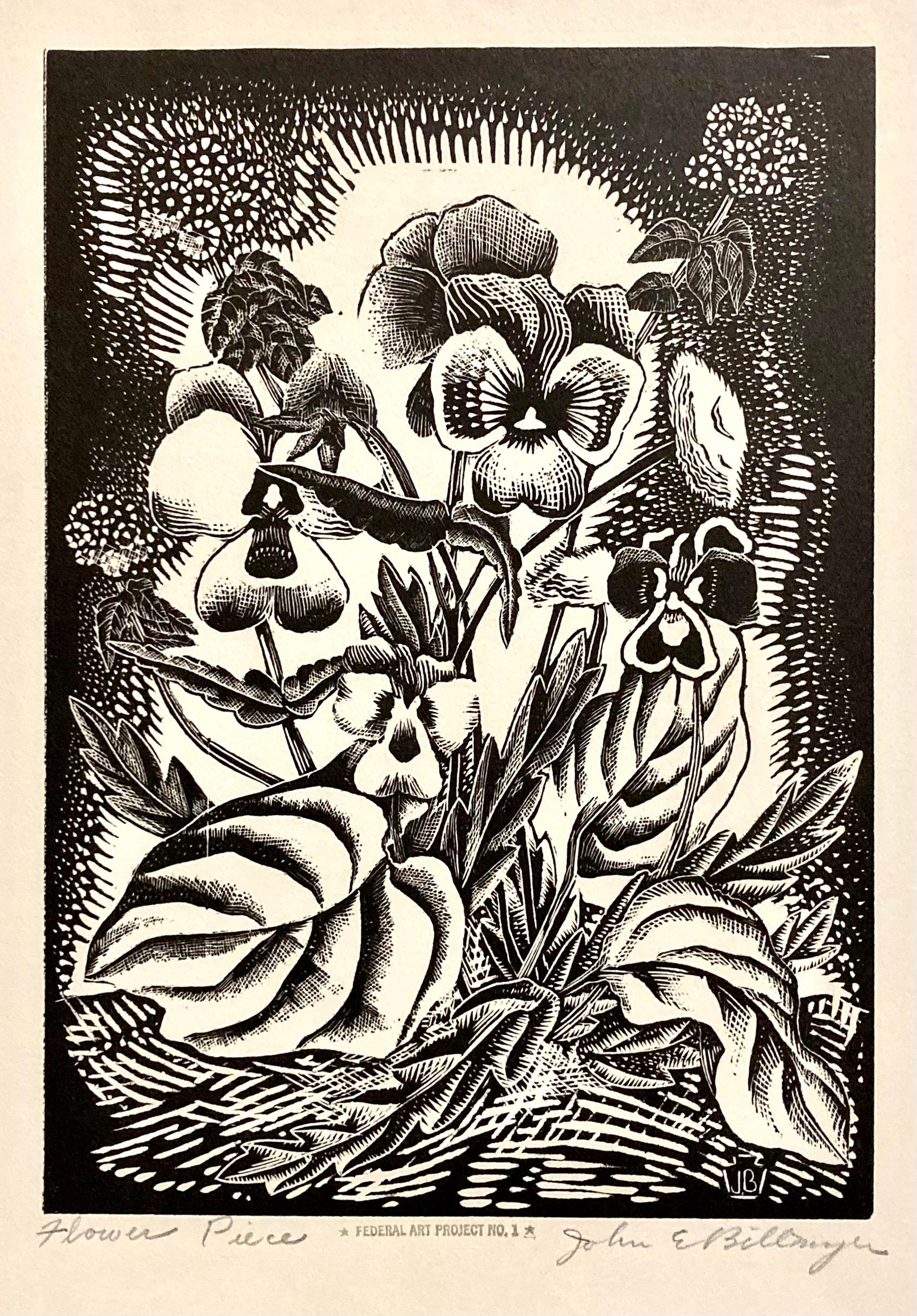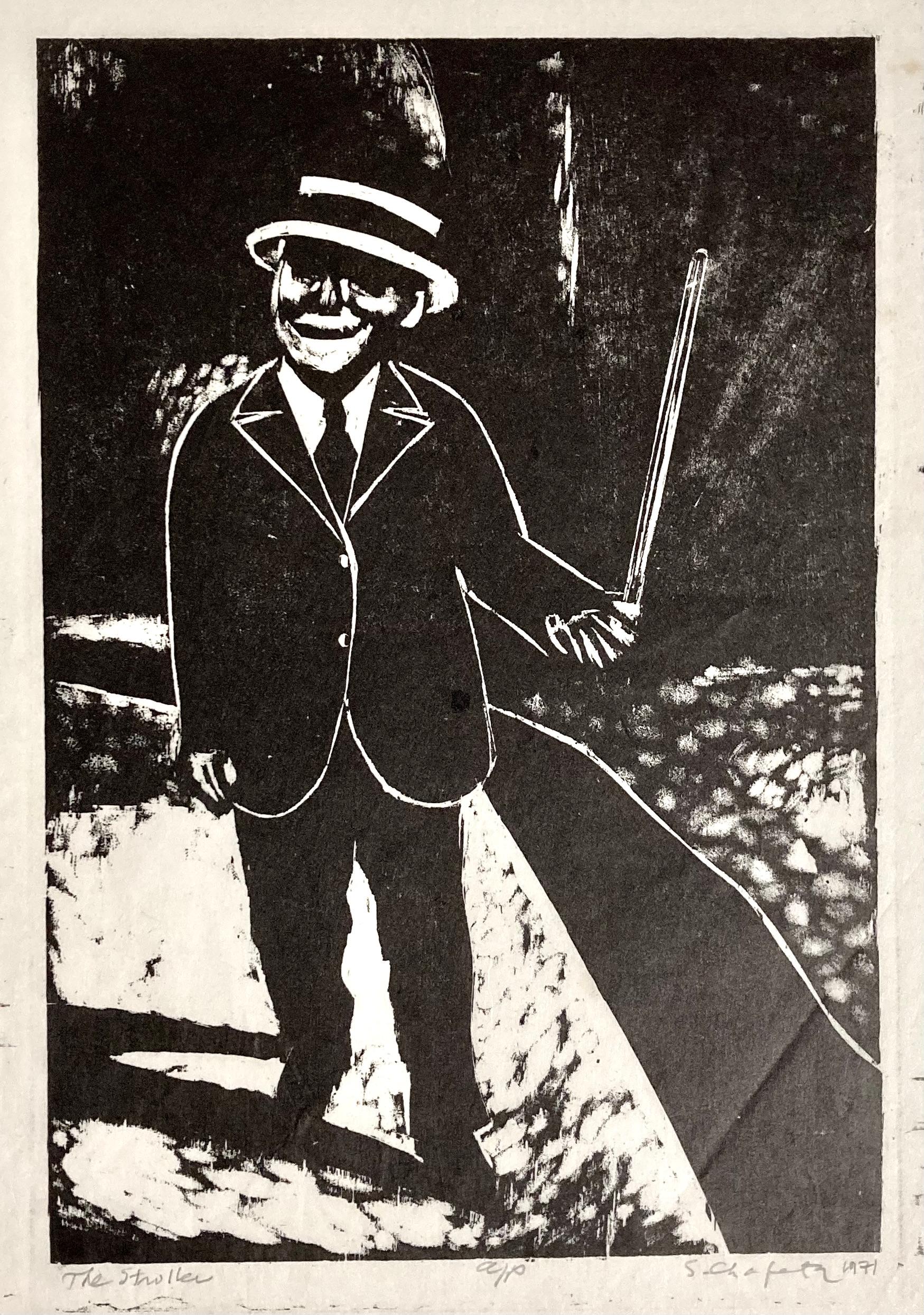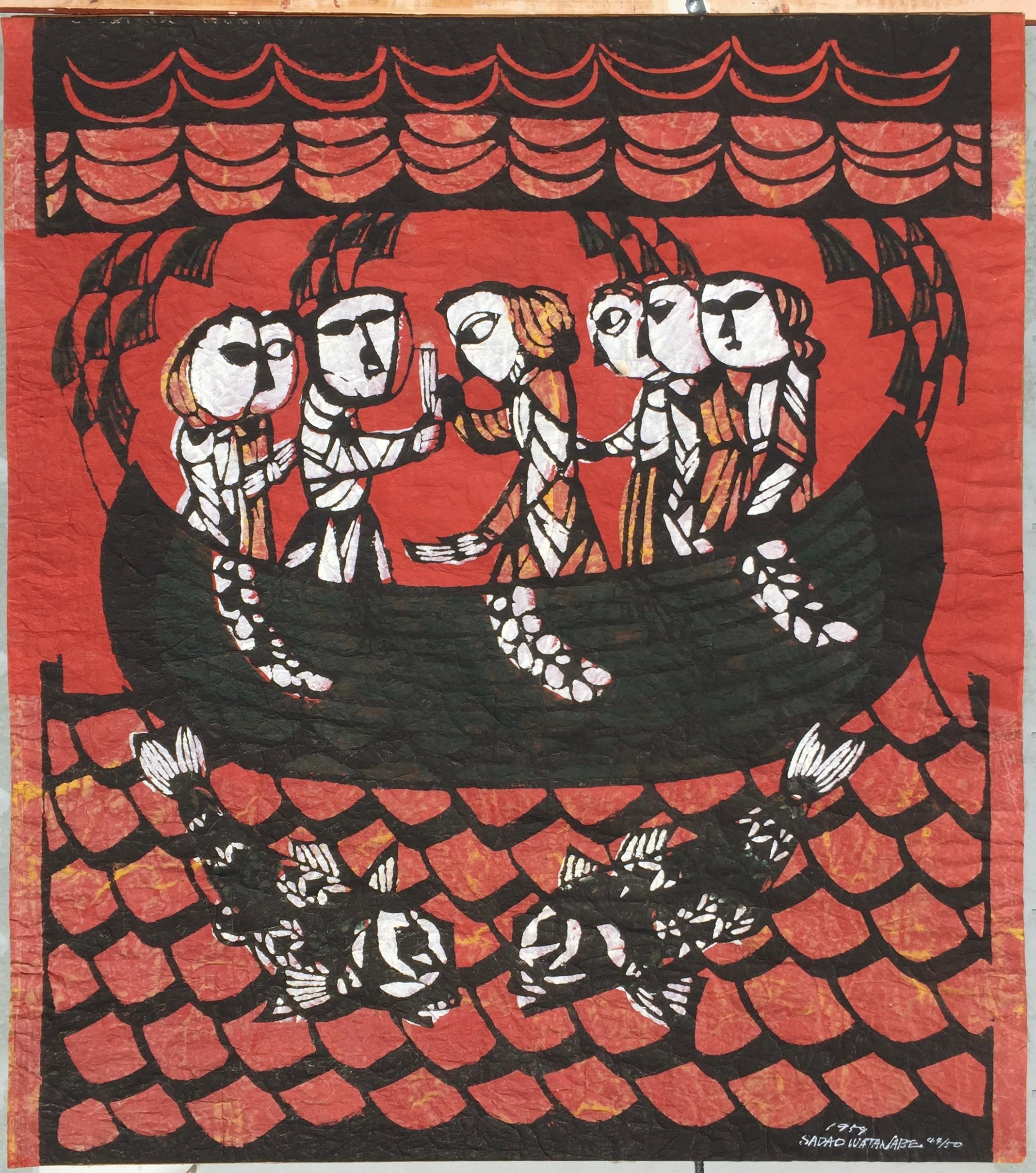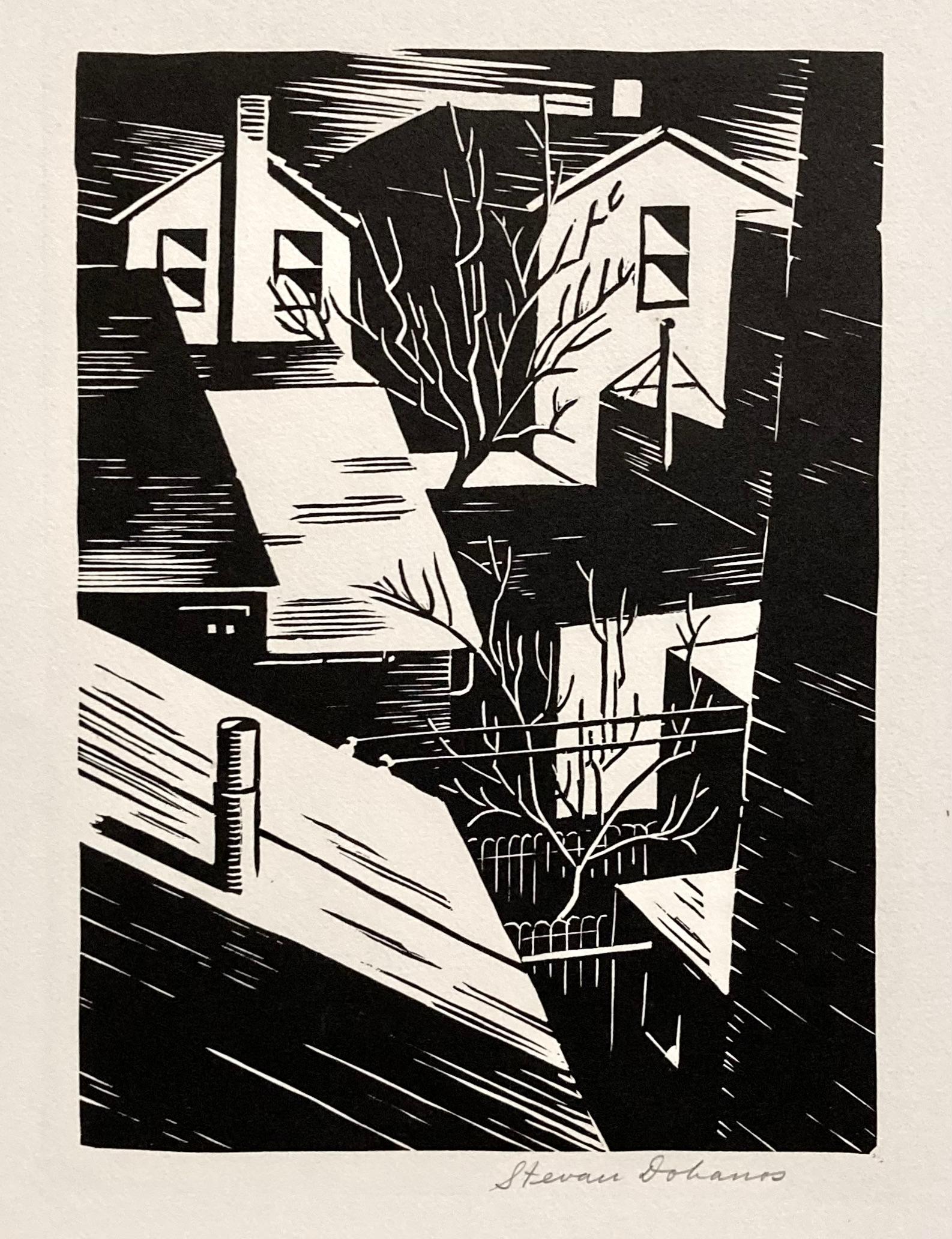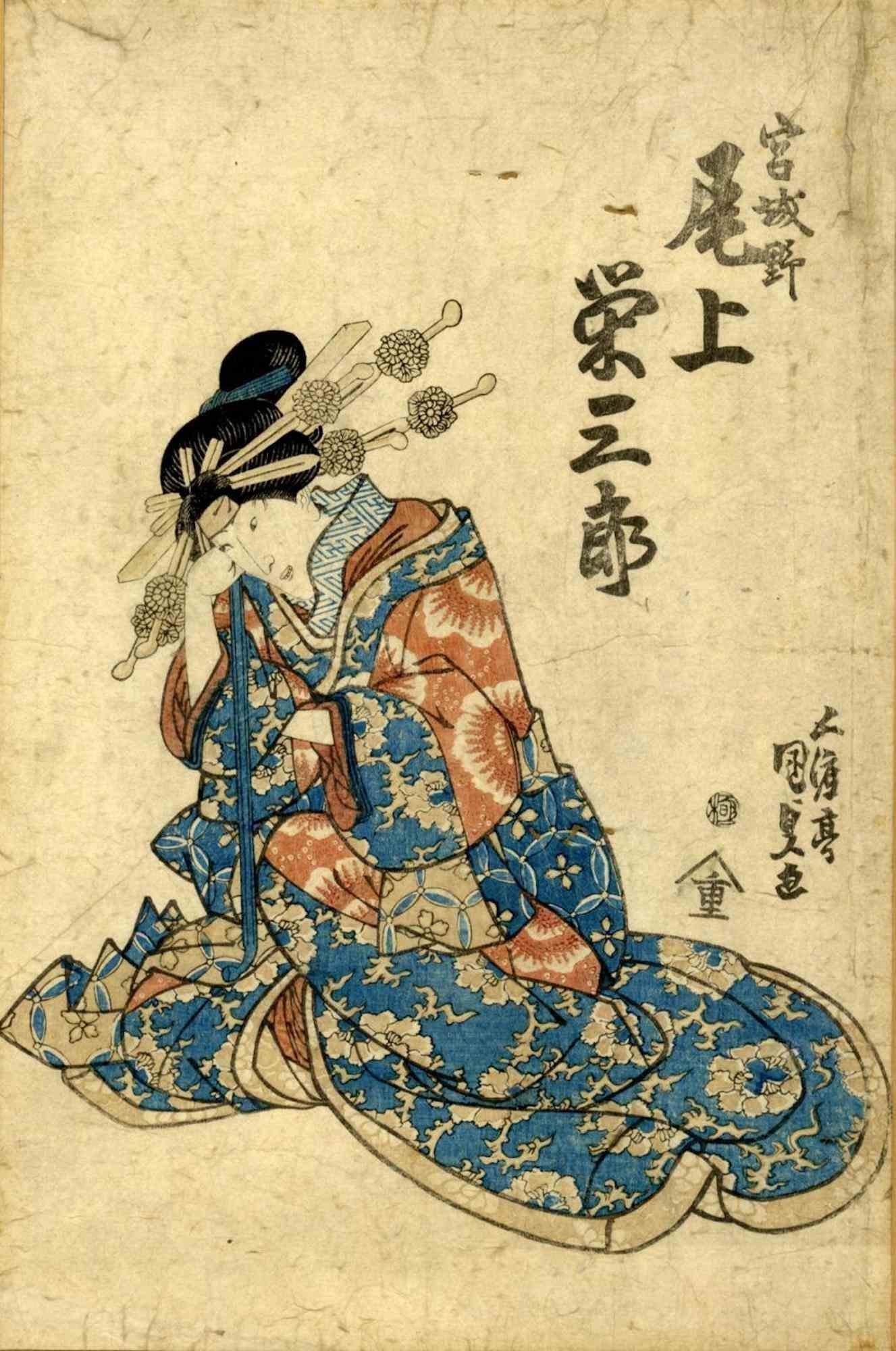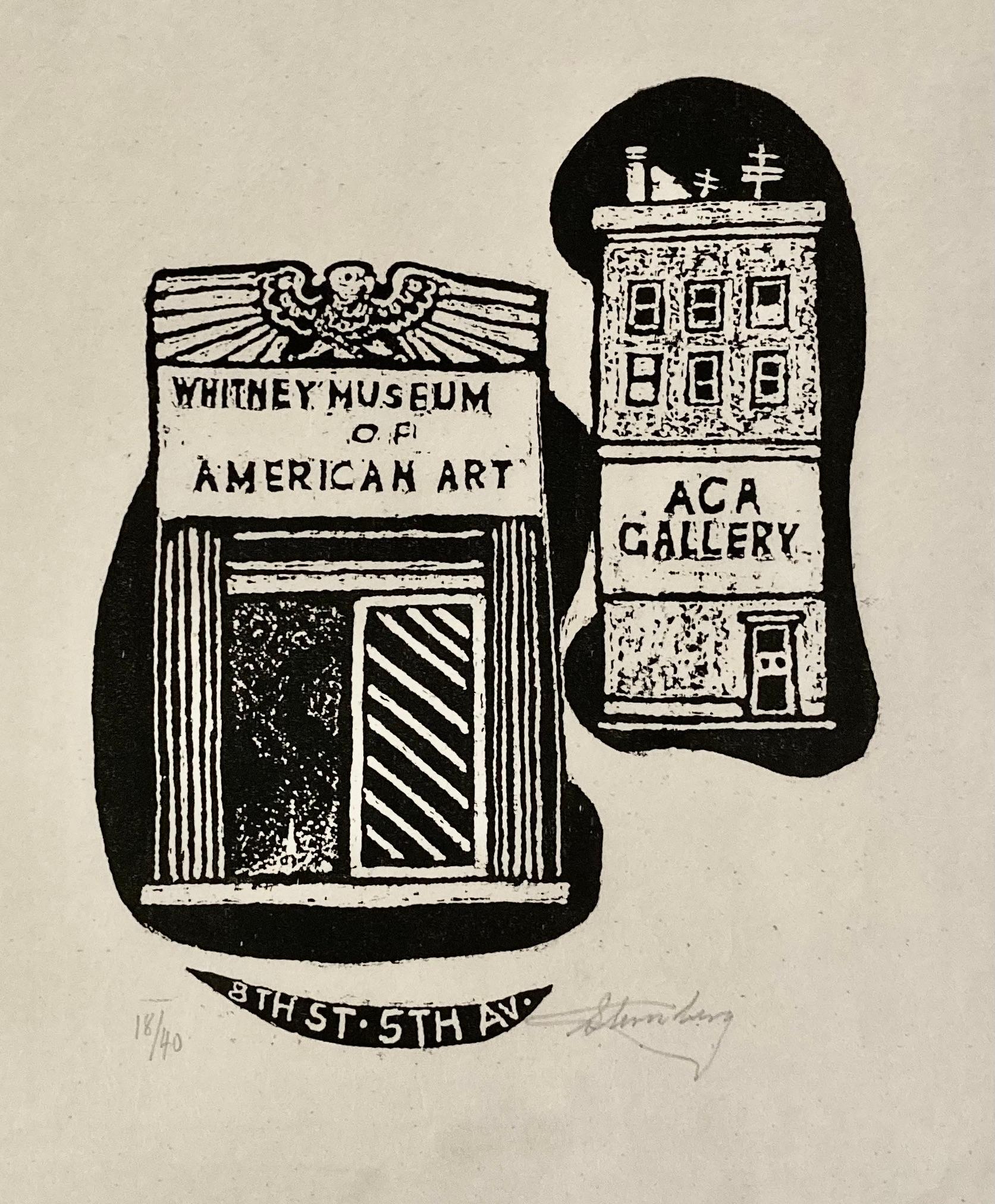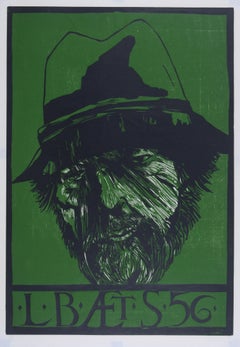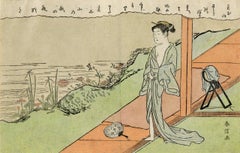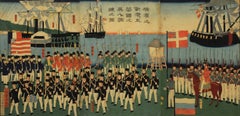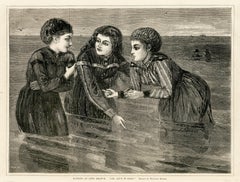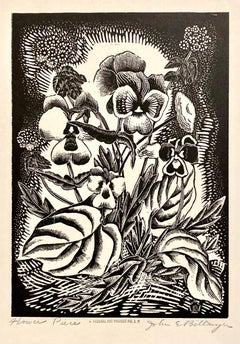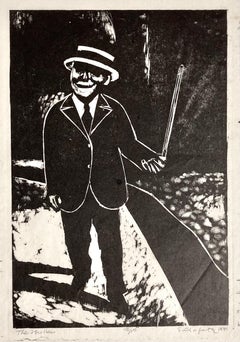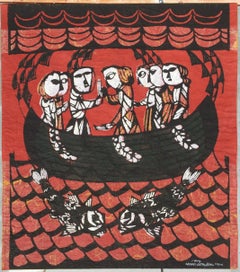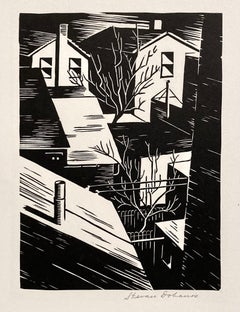Items Similar to No Footprints Show, Where the Flowers Grow Deep
Want more images or videos?
Request additional images or videos from the seller
1 of 7
Shiko MunakataNo Footprints Show, Where the Flowers Grow Deep1961
1961
About the Item
No Footprints Show, Where the Flowers Grow Deep
Woodcut, 1961
Unsigned (as isssued)
From: The "Way" of the Woodcut, three woodcuts, 1961
Publisher: Pratt Adlib Press, Brooklyn, New York,1961
Printer: James Lanier at the Press of Igal Roodenko
Edition: 1500 books
Public Collections: MOMA
Library of Congress
Toledo Museum of Art
Condition: Excellent
Image/Sheet size: 12 x 8 1/4 inches
MUNAKATA, SHIKO (1903 - 1975 )
Born in Aomori prefecture, Shiko Munakata is a woodblock print artist best known for his black and white prints and his expressive, sketch-like lines. A self-taught artist, he began his career in oil painting, organizing the Seikokai (Blue Light Group) and exhibiting at Hakujitsukai, Bunten and Teiten. Shiko Munakata changed course in 1926 upon seeing a woodblock print by Sumio Kawakami. After brief instruction from Un’ichi Hiratsuka in 1928, Munakata became active in the woodblock printmaking community: he belonged to both Kokugakai (1932-1953) and Nihon Hanga Kyokai (1932-1938), and contributed to many Sosaku Hanga publications. Around 1936, he garnered the support of Soetsu Yamagai and other leaders of the folk art movement. Shiko Munakata’s work began to heavily feature Buddhist imagery the following year. During the bombing of Tokyo in 1945, he escaped to Toyama prefecture. Shiko Manukata continued woodblock printmaking and received first prize in international exhibitions held in Lugano (1952), Sao Paulo (1955) and Venice (1956). Visiting the United States in 1959, Munakata spent a year exhibiting his work throughout the country. Horinji Temple in Kyoto bestowed him with the honorary rank of “Hokkyo” upon his return to Japan. In 1962, he received the rank of “Hogan” from Nisseki Temple in Toyama prefecture. Shiko Munakata’s accolades continued through the end of the decade, including the Medal of Honor (1963), the Asahi Shimbun culture prize (1965), and the Order of Cultural Merit (1970).
Courtesy Ronin
Munakata 1959 Buddhis triadMunakata's prints have a distinctive spontaneity and spiritual energy. He saw himself as a temporary medium through which the design, not really his own, could be revealed. As a result, unlike Onchi Kôshirô and other artists of the sôsaku hanga (creative print: 創作版画) movement who advocated self-expression in their printmaking, Munakata disclaimed individual responsibility as an artist. For him, artistic creation was only one of many manifestations of nature's force and beauty, which is inherent in the woodblock. In Munakata's words, "The essence of hanga lies in the fact that one must give in to the ways of the board ... there is a power in the board, and one cannot force the tool against that power."
Munakata's works are in numerous private collections and in public institutions, including the Art Gallery of New South Wales; Art Institute of Chicago; Asian Art Museum, San Francisco; British Museum, London; Brooklyn Museum, New York; Carnegie Museum of Art, Pittsburgh; Cincinnati Art Museum; Detroit Institute of Art; Fine Art Museums of San Francisco; Harvard Art Museums; Honolulu Museum of Art; Japan Folk Art Museum, Tokyo; Los Angeles County Museum of Art;Metropolitan Museum of Art, New York; Minneapolis Museum of Art; Munakata Shikô Memorial Museum of Art; Museum of Fine Arts, Boston; Museum of Modern Art, New York; Museum of Modern Art, Tokyo; National Museum of Asian Art (Smithsonian), Washington, D.C.; National Museum of Modern Art, Kyoto; National Museum of Modern Art, Tokyo; Philadelphia Museum of Art; and Rijksmuseum, Amsterdam
Courtesy: Viewing Japanese Prints
- Creator:Shiko Munakata (1903 - 1975, Japanese)
- Creation Year:1961
- Dimensions:Height: 12 in (30.48 cm)Width: 8.25 in (20.96 cm)
- Medium:
- Movement & Style:
- Period:
- Condition:
- Gallery Location:Fairlawn, OH
- Reference Number:Seller: FA125221stDibs: LU14014139632
Shiko Munakata
Shiko Munakata is by many regarded as one of the most significant modern Japanese artists of the twentieth century. His art work consists of paintings, prints, ceramics and calligraphy. Looking at his art work, the way he produced it and his fame, one could be tempted to call him the Japanese Picasso of the twentieth century - in every aspect. Born in Aomori Shiko Munakata was born as the son of a blacksmith in Aomori Prefecture, located in the North of Japan's main island. He first began to paint in oil as a self-taught artist. Later in 1924 he went to Tokyo to study art. Three years after the artist's death, the city of Aomori opened the Munakata Shiko Memorial Museum of Art. The museum web site has one page with a summary of the career of the artist in English. At the age of 23 Munakata Shiko saw a woodblock print by Sumio Kawakami and decided to try woodblocks himself. Under the guidance of Unichi Hiratuka he learned the art of making moku-hanga - woodblock prints. Three years later he exhibited four woodblocks at the Shunyokai exhibition. From then on Munakata Shiko was a hanga artist - a print artist. He continued to exhibit and by and by his reputation grew. After World War II had ended, the artist became famous outside Japan. His works were shown at the Lugano Print Exhibition in 1952, the Sao Paulo Biennal in 1955, the Venice Biennal in 1956. In each of these exhibitions he was awarded with first prizes. After these successful exhibition, Munakata went to the U.S., where he lectured at different universities and had numerous solo exhibitions. Munakata Shiko preferred to call his prints banga, which could be translated like picture made from a wooden panel. Munakata was a practicing Buddhist. Many of his prints and paintings show religious subjects. Other subjects are taken from Japanese legends or from nature. Munakata's prints are larger than the traditional Japanese oban (10x15 inches = 25.4x38 cm) size. With his larger-sized prints he followed Western contemporary artist's and the buying habits of Western clients. Japanese homes are usually small and have little wall space to hang art work and therefore Japanese art buyers tend to buy smaller sizes. A Munakata print is usually in black and white. The techniques he used are woodblocks, woodcuts and lithographs. Like Pablo Picasso, Shiko Munakata worked spontaneously, fast and was extremely prolific. Shiko Munakata died in Tokyo in 1975 at the age of 72.
About the Seller
5.0
Recognized Seller
These prestigious sellers are industry leaders and represent the highest echelon for item quality and design.
Platinum Seller
Premium sellers with a 4.7+ rating and 24-hour response times
Established in 1978
1stDibs seller since 2013
784 sales on 1stDibs
Typical response time: 1 hour
Associations
International Fine Print Dealers Association
- ShippingRetrieving quote...Shipping from: Akron, OH
- Return Policy
Authenticity Guarantee
In the unlikely event there’s an issue with an item’s authenticity, contact us within 1 year for a full refund. DetailsMoney-Back Guarantee
If your item is not as described, is damaged in transit, or does not arrive, contact us within 7 days for a full refund. Details24-Hour Cancellation
You have a 24-hour grace period in which to reconsider your purchase, with no questions asked.Vetted Professional Sellers
Our world-class sellers must adhere to strict standards for service and quality, maintaining the integrity of our listings.Price-Match Guarantee
If you find that a seller listed the same item for a lower price elsewhere, we’ll match it.Trusted Global Delivery
Our best-in-class carrier network provides specialized shipping options worldwide, including custom delivery.More From This Seller
View AllSelf Portrait-L.B. AET 56
By Leonard Baskin
Located in Fairlawn, OH
Self Portrait-L.B. AET 56
Color woodcut printed in black and green, 1978
Signed in pencil lower right (see photo)
Edition: 150 (97/150)
Condition: Excellent
Image: 32 x 22”
Sheet: 35...
Category
1970s American Modern Figurative Prints
Materials
Woodcut
Beauty on a Veranda with Fan and Mirror
By Suzuki (Hozumi) Harunobu
Located in Fairlawn, OH
Signed: Harunobu ga
Series: Series: Eight Fashionable Parlor Views (Furyu zashiki hakkei)?
Format Japanese: chuban
Provenance:
Private Collection, Philadelphia
Collection of McCleaf
...
Category
Mid-18th Century Edo Prints and Multiples
Materials
Woodcut
Foreign Soldiers from Five Countries at the Port of Yokohama
By Utagawa Yoshitora
Located in Fairlawn, OH
Foreign Soldiers from Five Countries at the Port of Yokohama
Color woodcut triptych, c. 1860's
Signed in the block lower left corner Signed: "Ichimosai Yoshitora ga"
Condition: Mounted to a rose colored silk backing (stable)
Staining (visible) in the joining of the right and center sheets
Colors very slightly faded
Image size: 15 3/8 x 31 3/8 inches (triptysch sheets joined to make one print)
The 1854 Treaty of Kanagawa opened Japan to the West. Curiosity about the never-before-seen foreigners spurred a market in Yokohama-e (Yokohama prints), named for the area to which foreign dignitaries and merchants were confined. Yoshitora became one of the best known and most active artists of the Yokohama-e school.
Utagawa Yoshitora (歌川 芳虎) was a designer of ukiyo-e Japanese woodblock prints and an illustrator of books and newspapers who was active from about 1850 to about 1880. He was born in Edo (modern Tokyo), but neither his date of birth nor date of death is known. However, he was the oldest pupil of Utagawa Kuniyoshi who excelled in prints of warriors, kabuki actors, beautiful women, and foreigners (Yokohama-e). He may not have seen any of the foreign scenes he depicted.
Yoshitora was prolific: he produced over 60 print series and illustrated over 100 books. In 1849 he produced an irreverent print called Dōke musha: Miyo no wakamochi ("Funny Warriors—Our Ruler's New Year's Rice Cakes"), which depicts Oda Nobunaga, Akechi Mitsuhide, and Toyotomi Hideyoshi...
Category
Mid-19th Century Figurative Prints
Materials
Woodcut
Bathing at Long Branch-“Oh, Ain’t it Cold”
By Winslow Homer
Located in Fairlawn, OH
Bathing at Long Branch-“Oh, Ain’t it Cold”
Wood engraving, 1871
Signed in the block with the artist's initials "WH", see photo
Published in: Every Saturday, Aug. 16, 1871
Condition: ...
Category
1870s Hudson River School Figurative Prints
Materials
Woodcut
Plate 12
By Wassily Kandinsky
Located in Fairlawn, OH
Plate 12
From: 10 Origi, 1942
Signed in the block with the artist's initials lower left (printed)
From: 10 Origin
Not from the First edition 100, published by Allianz-Verlag, Zurich,...
Category
1970s Expressionist Abstract Prints
Materials
Woodcut
Arashi Rikan II in an Osaka Kabuki Scene
Located in Fairlawn, OH
Arashi Rikan II in an Osaka Kabuki Scene
Color woodcut, c. 1827
Signed middle left (see photo)
Titled upper left (see photo)
Format: oban
Publisher: Honsei
The actor, in character, d...
Category
1820s Other Art Style Figurative Prints
Materials
Woodcut
You May Also Like
John E. Billmyer, Flower Piece
Located in New York, NY
'Flower Piece' shows the artist, John Billmyer, to be a highly accomplished wood engraver. There are endless patterns and created details -- all executed flawlessly. Mostly made up o...
Category
Mid-20th Century American Modern Figurative Prints
Materials
Woodcut
Sidney Chafetz, The Stroller (Wallace Stevens)
Located in New York, NY
Sidney Chafetz was known for his clever compositions and his many portraits, all made in the most 'difficult to control' medium of woodcut.. This charmi...
Category
1970s American Modern Figurative Prints
Materials
Woodcut
Jonah
By Sadao Watanabe
Located in Santa Monica, CA
SADAO WATANABE (Japanese 1913-1996)
JONAH, 1959
Color stencil, signed, numbered and dated in white ink. Sheet, 25 5/8 x 22 5/8 inches. Edition: 44/50. Good color and generally good ...
Category
1950s Modern Figurative Prints
Materials
Stencil, Woodcut
$1,200 Sale Price
20% Off
Stevan Dohanos, Backyard
By Stevan Dohanos
Located in New York, NY
Stevan Dohanos was an accomplished draftsman who work was widely known through the Saturday Evening Post. This print 'Backyard,' however, leaves aside the illustrative magazine work ...
Category
1930s American Modern Landscape Prints
Materials
Woodcut
The Actor Onoe Eisaburo - Woodcut Print by Utagawa Kunisada - 1830s
Located in Roma, IT
The actor Onoe Eisaburo is an modern artwork realized by Utagawa Kunisada in 1830s.
Woodcut Print Oban Format.
The actor Onoe Eisaburo in the role of the high-ranking courtesan Miy...
Category
19th Century Modern Figurative Prints
Materials
Woodcut
Harry Sternberg, Whitney and ACA, from My Life in Woodcuts, 1991
By Harry Sternberg
Located in New York, NY
In 1991 Harry Sternberg published a book with Brighton Press, San Diego. It was My Life in Woodcuts. At the time it was the only known woodcut autobiography.
The deluxe editions of...
Category
1990s American Modern Figurative Prints
Materials
Woodcut
